Manage Operational Plan
VerifiedAdded on 2023/01/16
|18
|3300
|29
AI Summary
This document provides guidance on managing operational plans. It includes information on skills and knowledge activities, creating a business proposal, financial resource requirements, risk assessment, implementation, and key performance indicators.
Contribute Materials
Your contribution can guide someone’s learning journey. Share your
documents today.
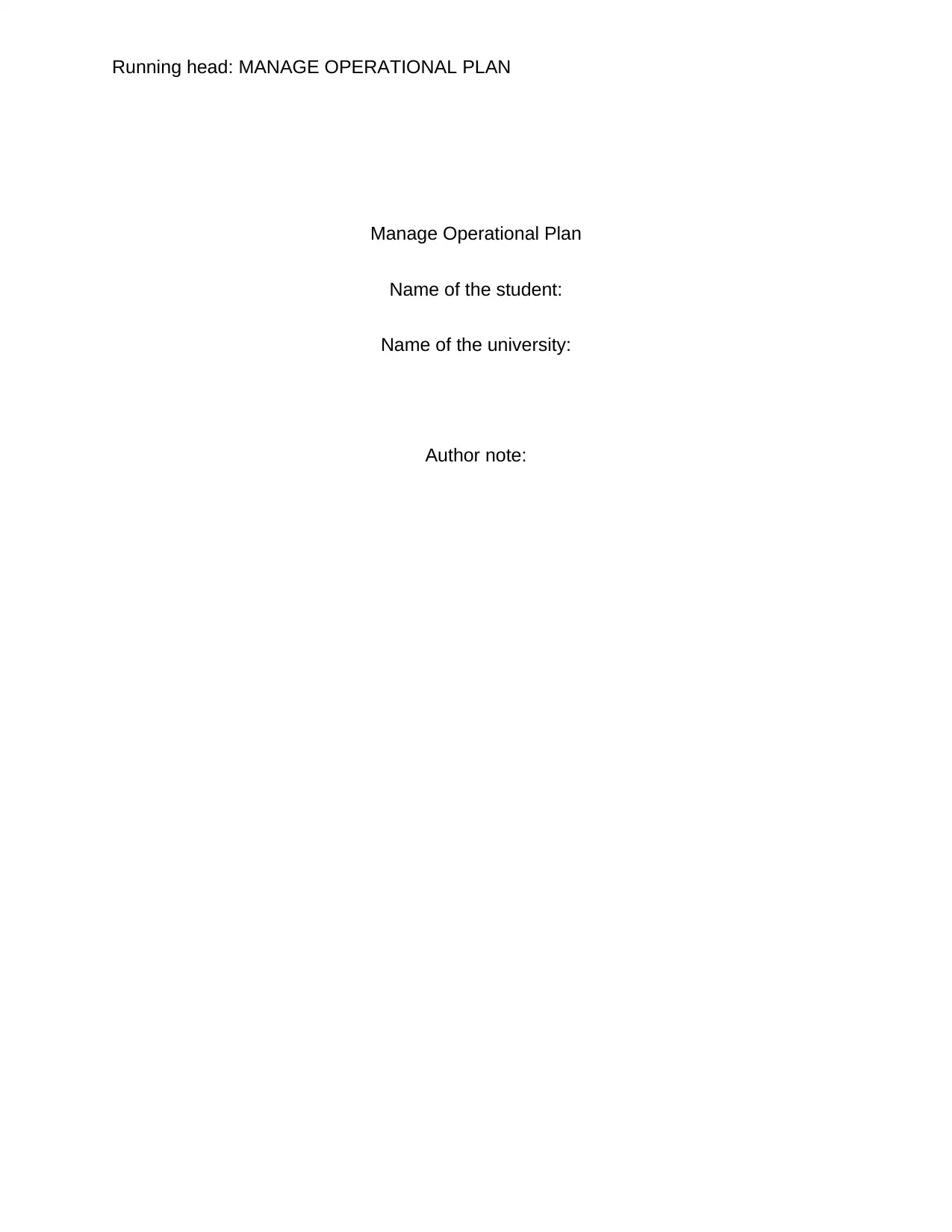
Running head: MANAGE OPERATIONAL PLAN
Manage Operational Plan
Name of the student:
Name of the university:
Author note:
Manage Operational Plan
Name of the student:
Name of the university:
Author note:
Secure Best Marks with AI Grader
Need help grading? Try our AI Grader for instant feedback on your assignments.
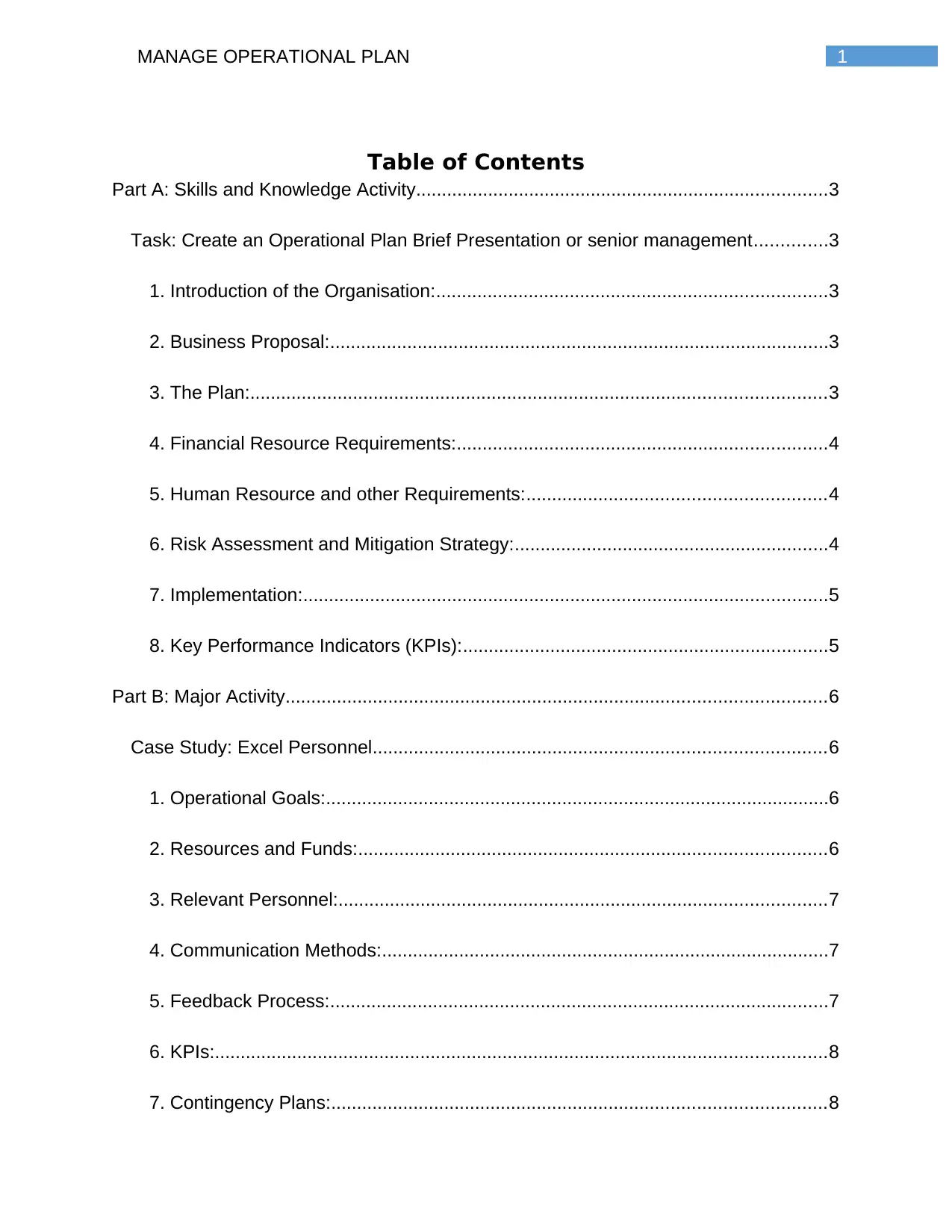
1MANAGE OPERATIONAL PLAN
Table of Contents
Part A: Skills and Knowledge Activity................................................................................3
Task: Create an Operational Plan Brief Presentation or senior management..............3
1. Introduction of the Organisation:............................................................................3
2. Business Proposal:.................................................................................................3
3. The Plan:................................................................................................................3
4. Financial Resource Requirements:........................................................................4
5. Human Resource and other Requirements:..........................................................4
6. Risk Assessment and Mitigation Strategy:.............................................................4
7. Implementation:......................................................................................................5
8. Key Performance Indicators (KPIs):.......................................................................5
Part B: Major Activity.........................................................................................................6
Case Study: Excel Personnel........................................................................................6
1. Operational Goals:..................................................................................................6
2. Resources and Funds:...........................................................................................6
3. Relevant Personnel:...............................................................................................7
4. Communication Methods:.......................................................................................7
5. Feedback Process:.................................................................................................7
6. KPIs:.......................................................................................................................8
7. Contingency Plans:................................................................................................8
Table of Contents
Part A: Skills and Knowledge Activity................................................................................3
Task: Create an Operational Plan Brief Presentation or senior management..............3
1. Introduction of the Organisation:............................................................................3
2. Business Proposal:.................................................................................................3
3. The Plan:................................................................................................................3
4. Financial Resource Requirements:........................................................................4
5. Human Resource and other Requirements:..........................................................4
6. Risk Assessment and Mitigation Strategy:.............................................................4
7. Implementation:......................................................................................................5
8. Key Performance Indicators (KPIs):.......................................................................5
Part B: Major Activity.........................................................................................................6
Case Study: Excel Personnel........................................................................................6
1. Operational Goals:..................................................................................................6
2. Resources and Funds:...........................................................................................6
3. Relevant Personnel:...............................................................................................7
4. Communication Methods:.......................................................................................7
5. Feedback Process:.................................................................................................7
6. KPIs:.......................................................................................................................8
7. Contingency Plans:................................................................................................8
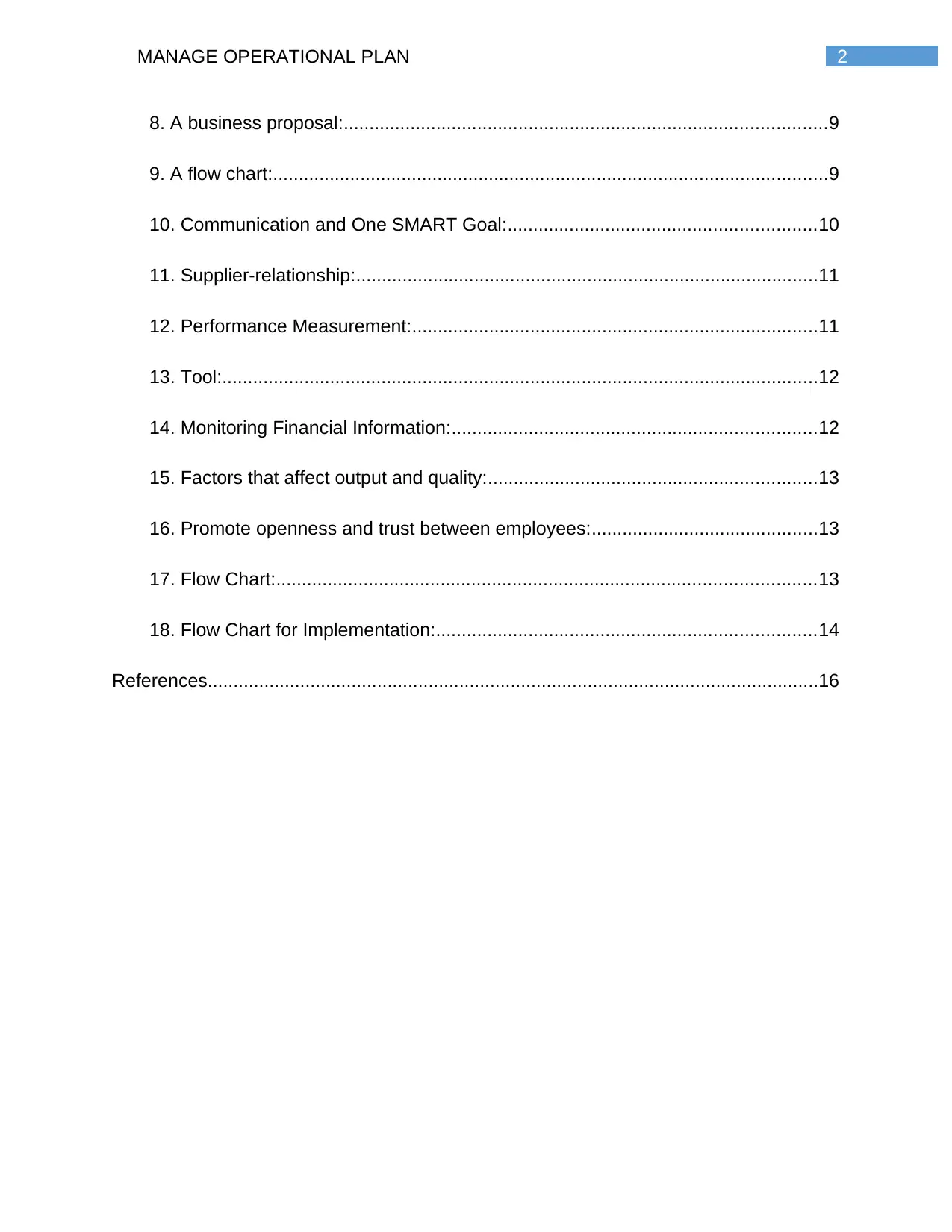
2MANAGE OPERATIONAL PLAN
8. A business proposal:..............................................................................................9
9. A flow chart:............................................................................................................9
10. Communication and One SMART Goal:............................................................10
11. Supplier-relationship:..........................................................................................11
12. Performance Measurement:...............................................................................11
13. Tool:....................................................................................................................12
14. Monitoring Financial Information:.......................................................................12
15. Factors that affect output and quality:................................................................13
16. Promote openness and trust between employees:............................................13
17. Flow Chart:.........................................................................................................13
18. Flow Chart for Implementation:..........................................................................14
References.......................................................................................................................16
8. A business proposal:..............................................................................................9
9. A flow chart:............................................................................................................9
10. Communication and One SMART Goal:............................................................10
11. Supplier-relationship:..........................................................................................11
12. Performance Measurement:...............................................................................11
13. Tool:....................................................................................................................12
14. Monitoring Financial Information:.......................................................................12
15. Factors that affect output and quality:................................................................13
16. Promote openness and trust between employees:............................................13
17. Flow Chart:.........................................................................................................13
18. Flow Chart for Implementation:..........................................................................14
References.......................................................................................................................16
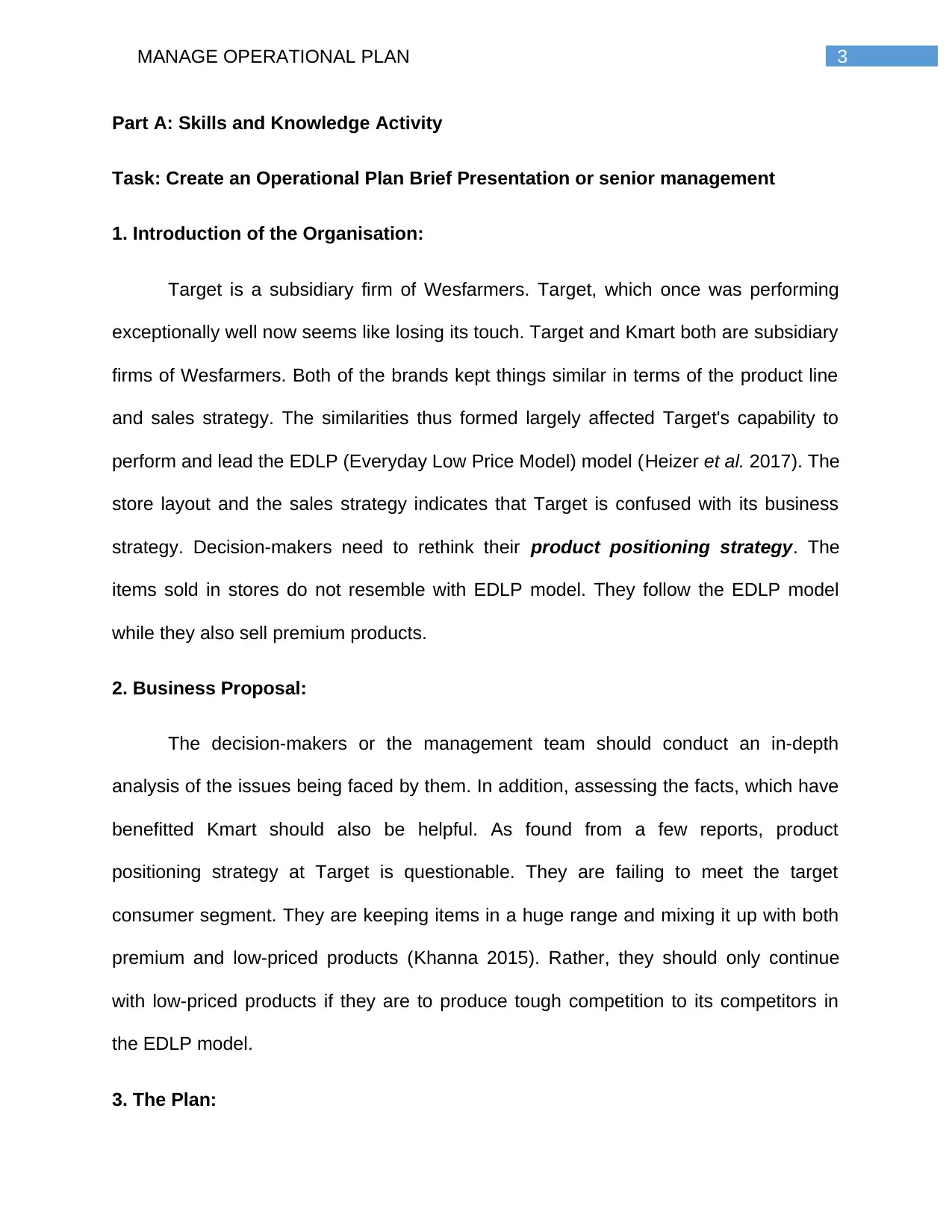
3MANAGE OPERATIONAL PLAN
Part A: Skills and Knowledge Activity
Task: Create an Operational Plan Brief Presentation or senior management
1. Introduction of the Organisation:
Target is a subsidiary firm of Wesfarmers. Target, which once was performing
exceptionally well now seems like losing its touch. Target and Kmart both are subsidiary
firms of Wesfarmers. Both of the brands kept things similar in terms of the product line
and sales strategy. The similarities thus formed largely affected Target's capability to
perform and lead the EDLP (Everyday Low Price Model) model (Heizer et al. 2017). The
store layout and the sales strategy indicates that Target is confused with its business
strategy. Decision-makers need to rethink their product positioning strategy. The
items sold in stores do not resemble with EDLP model. They follow the EDLP model
while they also sell premium products.
2. Business Proposal:
The decision-makers or the management team should conduct an in-depth
analysis of the issues being faced by them. In addition, assessing the facts, which have
benefitted Kmart should also be helpful. As found from a few reports, product
positioning strategy at Target is questionable. They are failing to meet the target
consumer segment. They are keeping items in a huge range and mixing it up with both
premium and low-priced products (Khanna 2015). Rather, they should only continue
with low-priced products if they are to produce tough competition to its competitors in
the EDLP model.
3. The Plan:
Part A: Skills and Knowledge Activity
Task: Create an Operational Plan Brief Presentation or senior management
1. Introduction of the Organisation:
Target is a subsidiary firm of Wesfarmers. Target, which once was performing
exceptionally well now seems like losing its touch. Target and Kmart both are subsidiary
firms of Wesfarmers. Both of the brands kept things similar in terms of the product line
and sales strategy. The similarities thus formed largely affected Target's capability to
perform and lead the EDLP (Everyday Low Price Model) model (Heizer et al. 2017). The
store layout and the sales strategy indicates that Target is confused with its business
strategy. Decision-makers need to rethink their product positioning strategy. The
items sold in stores do not resemble with EDLP model. They follow the EDLP model
while they also sell premium products.
2. Business Proposal:
The decision-makers or the management team should conduct an in-depth
analysis of the issues being faced by them. In addition, assessing the facts, which have
benefitted Kmart should also be helpful. As found from a few reports, product
positioning strategy at Target is questionable. They are failing to meet the target
consumer segment. They are keeping items in a huge range and mixing it up with both
premium and low-priced products (Khanna 2015). Rather, they should only continue
with low-priced products if they are to produce tough competition to its competitors in
the EDLP model.
3. The Plan:
Secure Best Marks with AI Grader
Need help grading? Try our AI Grader for instant feedback on your assignments.
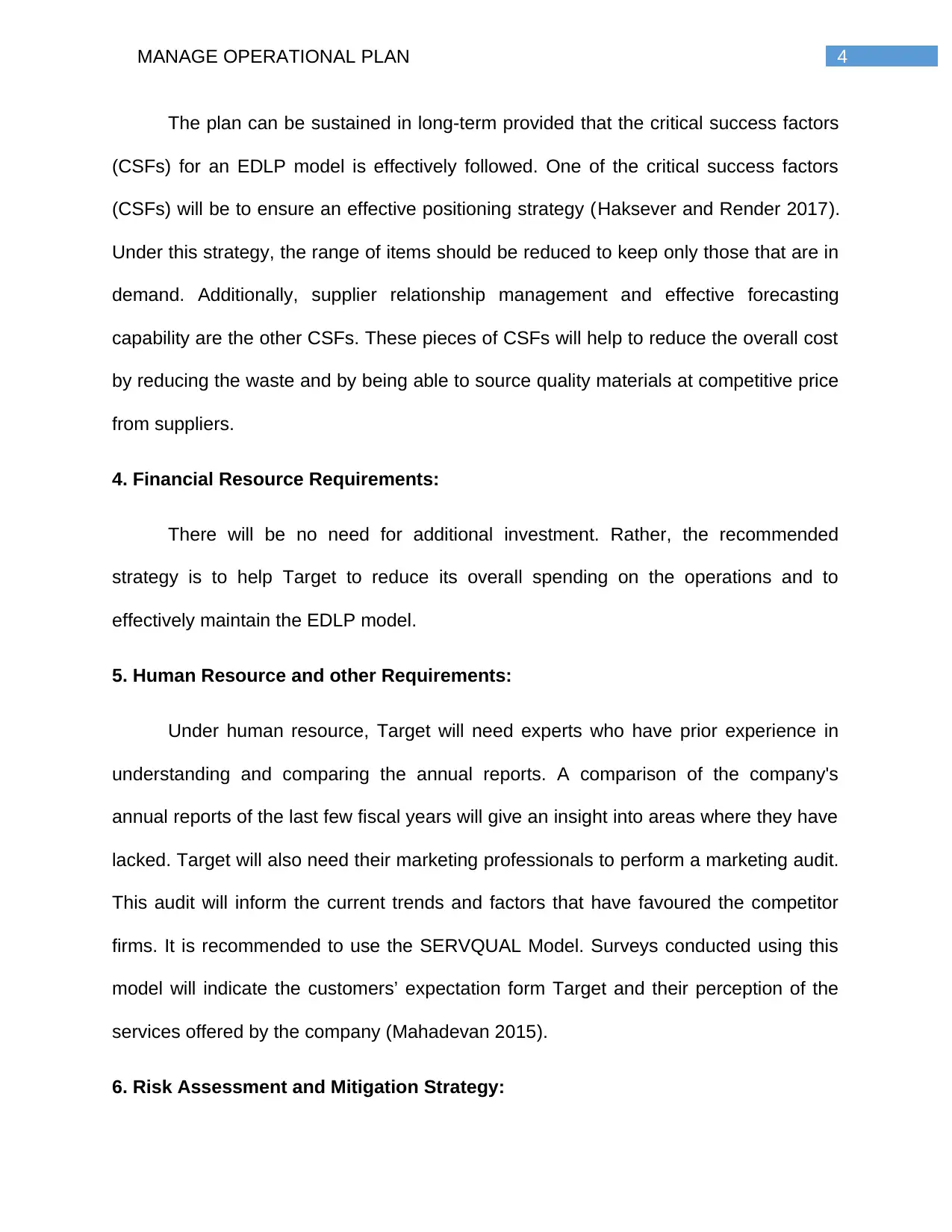
4MANAGE OPERATIONAL PLAN
The plan can be sustained in long-term provided that the critical success factors
(CSFs) for an EDLP model is effectively followed. One of the critical success factors
(CSFs) will be to ensure an effective positioning strategy (Haksever and Render 2017).
Under this strategy, the range of items should be reduced to keep only those that are in
demand. Additionally, supplier relationship management and effective forecasting
capability are the other CSFs. These pieces of CSFs will help to reduce the overall cost
by reducing the waste and by being able to source quality materials at competitive price
from suppliers.
4. Financial Resource Requirements:
There will be no need for additional investment. Rather, the recommended
strategy is to help Target to reduce its overall spending on the operations and to
effectively maintain the EDLP model.
5. Human Resource and other Requirements:
Under human resource, Target will need experts who have prior experience in
understanding and comparing the annual reports. A comparison of the company's
annual reports of the last few fiscal years will give an insight into areas where they have
lacked. Target will also need their marketing professionals to perform a marketing audit.
This audit will inform the current trends and factors that have favoured the competitor
firms. It is recommended to use the SERVQUAL Model. Surveys conducted using this
model will indicate the customers’ expectation form Target and their perception of the
services offered by the company (Mahadevan 2015).
6. Risk Assessment and Mitigation Strategy:
The plan can be sustained in long-term provided that the critical success factors
(CSFs) for an EDLP model is effectively followed. One of the critical success factors
(CSFs) will be to ensure an effective positioning strategy (Haksever and Render 2017).
Under this strategy, the range of items should be reduced to keep only those that are in
demand. Additionally, supplier relationship management and effective forecasting
capability are the other CSFs. These pieces of CSFs will help to reduce the overall cost
by reducing the waste and by being able to source quality materials at competitive price
from suppliers.
4. Financial Resource Requirements:
There will be no need for additional investment. Rather, the recommended
strategy is to help Target to reduce its overall spending on the operations and to
effectively maintain the EDLP model.
5. Human Resource and other Requirements:
Under human resource, Target will need experts who have prior experience in
understanding and comparing the annual reports. A comparison of the company's
annual reports of the last few fiscal years will give an insight into areas where they have
lacked. Target will also need their marketing professionals to perform a marketing audit.
This audit will inform the current trends and factors that have favoured the competitor
firms. It is recommended to use the SERVQUAL Model. Surveys conducted using this
model will indicate the customers’ expectation form Target and their perception of the
services offered by the company (Mahadevan 2015).
6. Risk Assessment and Mitigation Strategy:
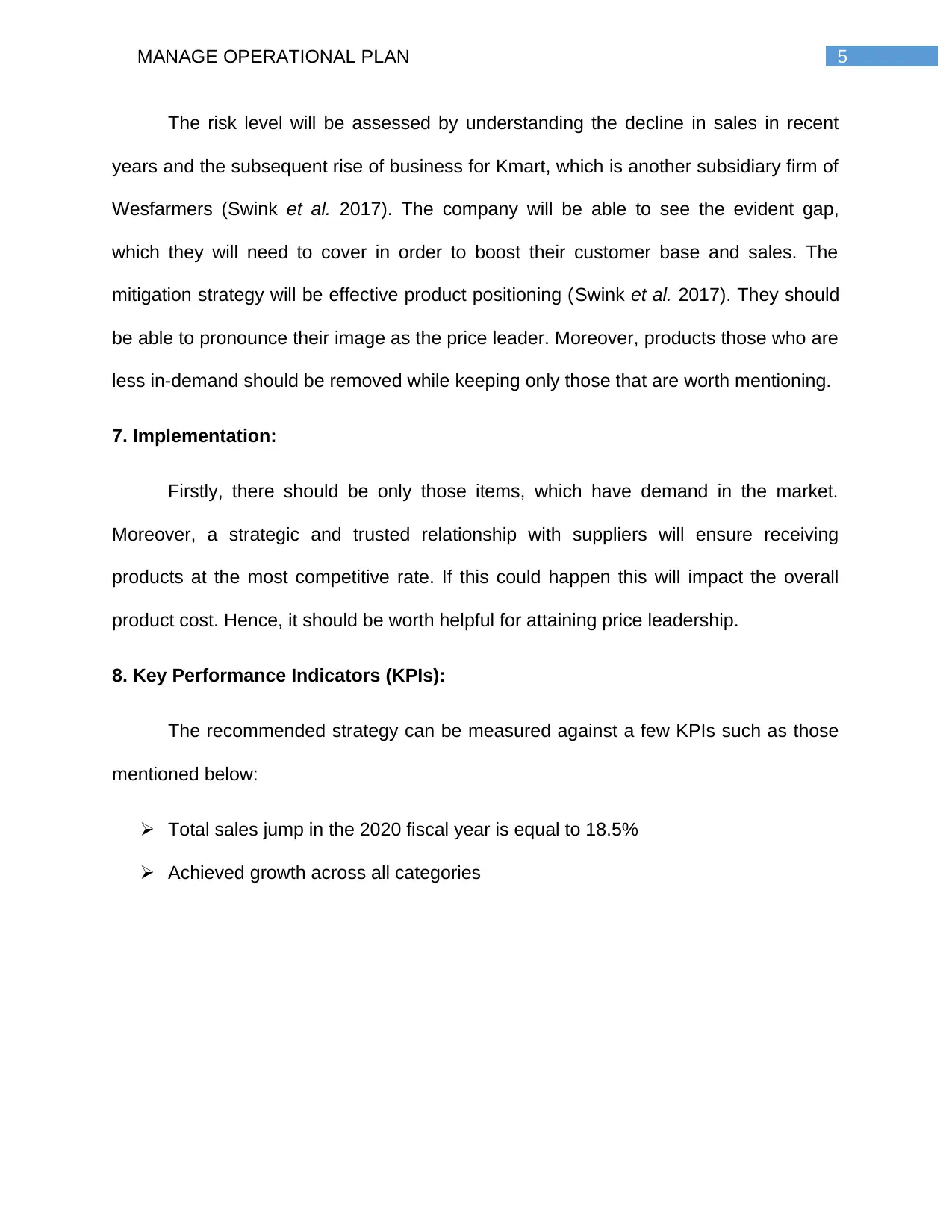
5MANAGE OPERATIONAL PLAN
The risk level will be assessed by understanding the decline in sales in recent
years and the subsequent rise of business for Kmart, which is another subsidiary firm of
Wesfarmers (Swink et al. 2017). The company will be able to see the evident gap,
which they will need to cover in order to boost their customer base and sales. The
mitigation strategy will be effective product positioning (Swink et al. 2017). They should
be able to pronounce their image as the price leader. Moreover, products those who are
less in-demand should be removed while keeping only those that are worth mentioning.
7. Implementation:
Firstly, there should be only those items, which have demand in the market.
Moreover, a strategic and trusted relationship with suppliers will ensure receiving
products at the most competitive rate. If this could happen this will impact the overall
product cost. Hence, it should be worth helpful for attaining price leadership.
8. Key Performance Indicators (KPIs):
The recommended strategy can be measured against a few KPIs such as those
mentioned below:
Total sales jump in the 2020 fiscal year is equal to 18.5%
Achieved growth across all categories
The risk level will be assessed by understanding the decline in sales in recent
years and the subsequent rise of business for Kmart, which is another subsidiary firm of
Wesfarmers (Swink et al. 2017). The company will be able to see the evident gap,
which they will need to cover in order to boost their customer base and sales. The
mitigation strategy will be effective product positioning (Swink et al. 2017). They should
be able to pronounce their image as the price leader. Moreover, products those who are
less in-demand should be removed while keeping only those that are worth mentioning.
7. Implementation:
Firstly, there should be only those items, which have demand in the market.
Moreover, a strategic and trusted relationship with suppliers will ensure receiving
products at the most competitive rate. If this could happen this will impact the overall
product cost. Hence, it should be worth helpful for attaining price leadership.
8. Key Performance Indicators (KPIs):
The recommended strategy can be measured against a few KPIs such as those
mentioned below:
Total sales jump in the 2020 fiscal year is equal to 18.5%
Achieved growth across all categories
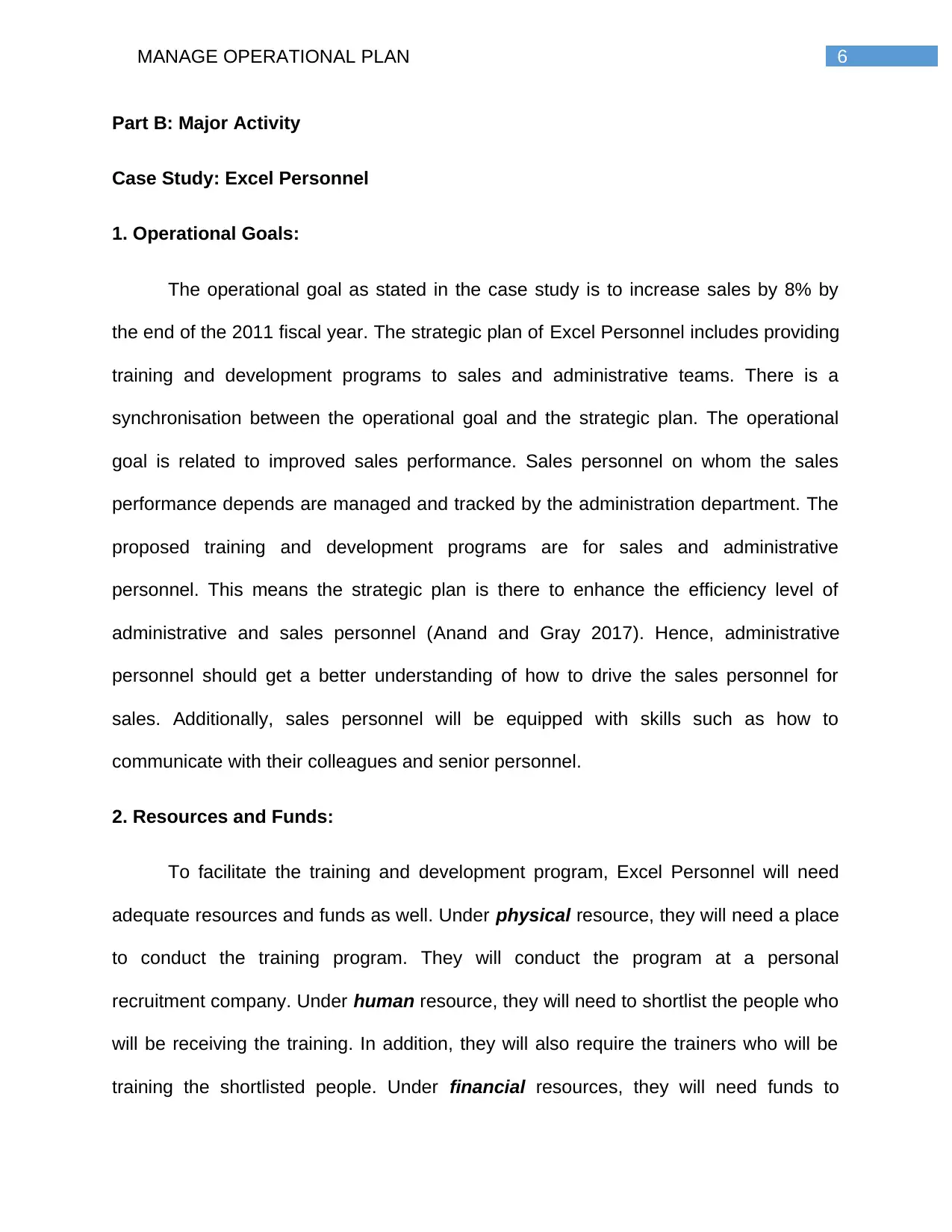
6MANAGE OPERATIONAL PLAN
Part B: Major Activity
Case Study: Excel Personnel
1. Operational Goals:
The operational goal as stated in the case study is to increase sales by 8% by
the end of the 2011 fiscal year. The strategic plan of Excel Personnel includes providing
training and development programs to sales and administrative teams. There is a
synchronisation between the operational goal and the strategic plan. The operational
goal is related to improved sales performance. Sales personnel on whom the sales
performance depends are managed and tracked by the administration department. The
proposed training and development programs are for sales and administrative
personnel. This means the strategic plan is there to enhance the efficiency level of
administrative and sales personnel (Anand and Gray 2017). Hence, administrative
personnel should get a better understanding of how to drive the sales personnel for
sales. Additionally, sales personnel will be equipped with skills such as how to
communicate with their colleagues and senior personnel.
2. Resources and Funds:
To facilitate the training and development program, Excel Personnel will need
adequate resources and funds as well. Under physical resource, they will need a place
to conduct the training program. They will conduct the program at a personal
recruitment company. Under human resource, they will need to shortlist the people who
will be receiving the training. In addition, they will also require the trainers who will be
training the shortlisted people. Under financial resources, they will need funds to
Part B: Major Activity
Case Study: Excel Personnel
1. Operational Goals:
The operational goal as stated in the case study is to increase sales by 8% by
the end of the 2011 fiscal year. The strategic plan of Excel Personnel includes providing
training and development programs to sales and administrative teams. There is a
synchronisation between the operational goal and the strategic plan. The operational
goal is related to improved sales performance. Sales personnel on whom the sales
performance depends are managed and tracked by the administration department. The
proposed training and development programs are for sales and administrative
personnel. This means the strategic plan is there to enhance the efficiency level of
administrative and sales personnel (Anand and Gray 2017). Hence, administrative
personnel should get a better understanding of how to drive the sales personnel for
sales. Additionally, sales personnel will be equipped with skills such as how to
communicate with their colleagues and senior personnel.
2. Resources and Funds:
To facilitate the training and development program, Excel Personnel will need
adequate resources and funds as well. Under physical resource, they will need a place
to conduct the training program. They will conduct the program at a personal
recruitment company. Under human resource, they will need to shortlist the people who
will be receiving the training. In addition, they will also require the trainers who will be
training the shortlisted people. Under financial resources, they will need funds to
Paraphrase This Document
Need a fresh take? Get an instant paraphrase of this document with our AI Paraphraser
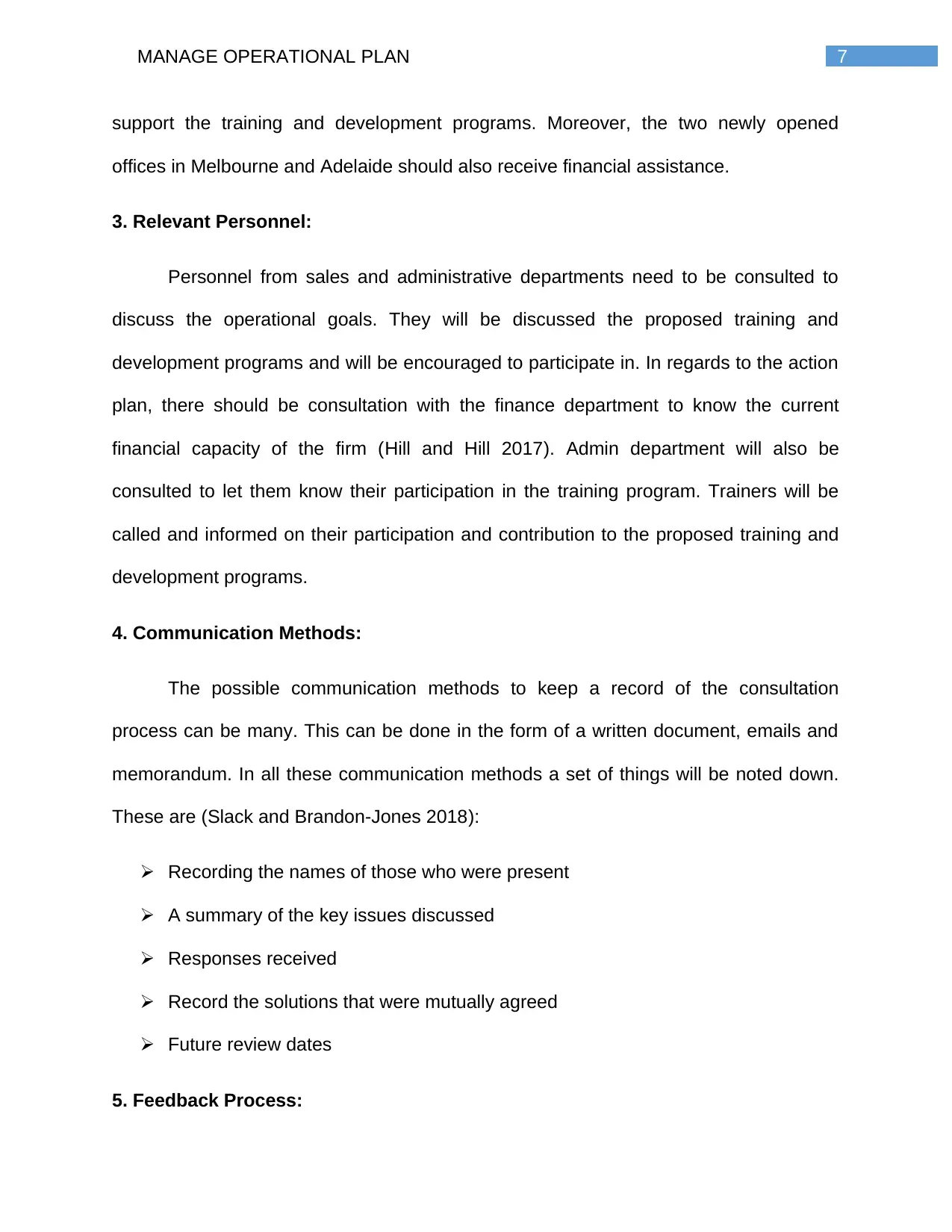
7MANAGE OPERATIONAL PLAN
support the training and development programs. Moreover, the two newly opened
offices in Melbourne and Adelaide should also receive financial assistance.
3. Relevant Personnel:
Personnel from sales and administrative departments need to be consulted to
discuss the operational goals. They will be discussed the proposed training and
development programs and will be encouraged to participate in. In regards to the action
plan, there should be consultation with the finance department to know the current
financial capacity of the firm (Hill and Hill 2017). Admin department will also be
consulted to let them know their participation in the training program. Trainers will be
called and informed on their participation and contribution to the proposed training and
development programs.
4. Communication Methods:
The possible communication methods to keep a record of the consultation
process can be many. This can be done in the form of a written document, emails and
memorandum. In all these communication methods a set of things will be noted down.
These are (Slack and Brandon-Jones 2018):
Recording the names of those who were present
A summary of the key issues discussed
Responses received
Record the solutions that were mutually agreed
Future review dates
5. Feedback Process:
support the training and development programs. Moreover, the two newly opened
offices in Melbourne and Adelaide should also receive financial assistance.
3. Relevant Personnel:
Personnel from sales and administrative departments need to be consulted to
discuss the operational goals. They will be discussed the proposed training and
development programs and will be encouraged to participate in. In regards to the action
plan, there should be consultation with the finance department to know the current
financial capacity of the firm (Hill and Hill 2017). Admin department will also be
consulted to let them know their participation in the training program. Trainers will be
called and informed on their participation and contribution to the proposed training and
development programs.
4. Communication Methods:
The possible communication methods to keep a record of the consultation
process can be many. This can be done in the form of a written document, emails and
memorandum. In all these communication methods a set of things will be noted down.
These are (Slack and Brandon-Jones 2018):
Recording the names of those who were present
A summary of the key issues discussed
Responses received
Record the solutions that were mutually agreed
Future review dates
5. Feedback Process:
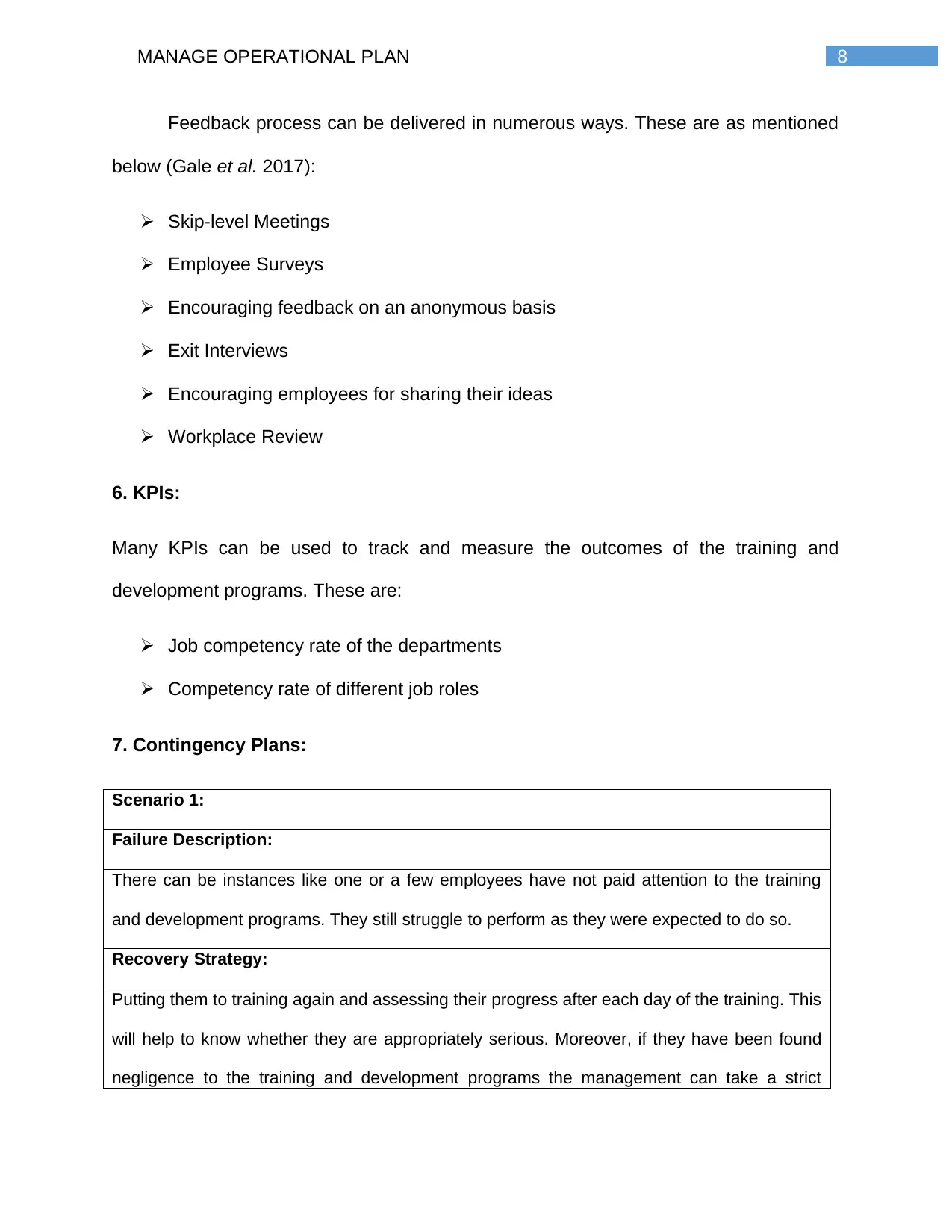
8MANAGE OPERATIONAL PLAN
Feedback process can be delivered in numerous ways. These are as mentioned
below (Gale et al. 2017):
Skip-level Meetings
Employee Surveys
Encouraging feedback on an anonymous basis
Exit Interviews
Encouraging employees for sharing their ideas
Workplace Review
6. KPIs:
Many KPIs can be used to track and measure the outcomes of the training and
development programs. These are:
Job competency rate of the departments
Competency rate of different job roles
7. Contingency Plans:
Scenario 1:
Failure Description:
There can be instances like one or a few employees have not paid attention to the training
and development programs. They still struggle to perform as they were expected to do so.
Recovery Strategy:
Putting them to training again and assessing their progress after each day of the training. This
will help to know whether they are appropriately serious. Moreover, if they have been found
negligence to the training and development programs the management can take a strict
Feedback process can be delivered in numerous ways. These are as mentioned
below (Gale et al. 2017):
Skip-level Meetings
Employee Surveys
Encouraging feedback on an anonymous basis
Exit Interviews
Encouraging employees for sharing their ideas
Workplace Review
6. KPIs:
Many KPIs can be used to track and measure the outcomes of the training and
development programs. These are:
Job competency rate of the departments
Competency rate of different job roles
7. Contingency Plans:
Scenario 1:
Failure Description:
There can be instances like one or a few employees have not paid attention to the training
and development programs. They still struggle to perform as they were expected to do so.
Recovery Strategy:
Putting them to training again and assessing their progress after each day of the training. This
will help to know whether they are appropriately serious. Moreover, if they have been found
negligence to the training and development programs the management can take a strict
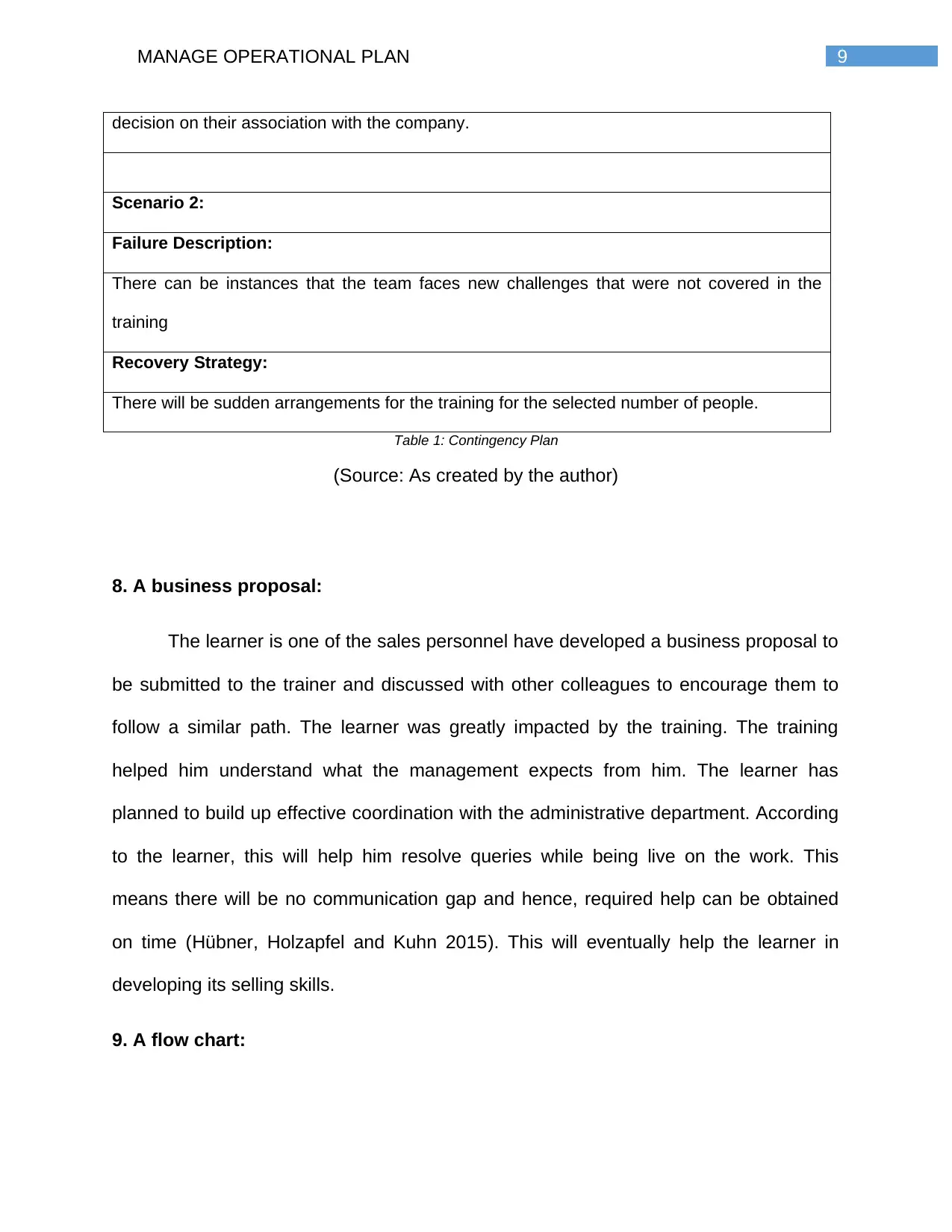
9MANAGE OPERATIONAL PLAN
decision on their association with the company.
Scenario 2:
Failure Description:
There can be instances that the team faces new challenges that were not covered in the
training
Recovery Strategy:
There will be sudden arrangements for the training for the selected number of people.
Table 1: Contingency Plan
(Source: As created by the author)
8. A business proposal:
The learner is one of the sales personnel have developed a business proposal to
be submitted to the trainer and discussed with other colleagues to encourage them to
follow a similar path. The learner was greatly impacted by the training. The training
helped him understand what the management expects from him. The learner has
planned to build up effective coordination with the administrative department. According
to the learner, this will help him resolve queries while being live on the work. This
means there will be no communication gap and hence, required help can be obtained
on time (Hübner, Holzapfel and Kuhn 2015). This will eventually help the learner in
developing its selling skills.
9. A flow chart:
decision on their association with the company.
Scenario 2:
Failure Description:
There can be instances that the team faces new challenges that were not covered in the
training
Recovery Strategy:
There will be sudden arrangements for the training for the selected number of people.
Table 1: Contingency Plan
(Source: As created by the author)
8. A business proposal:
The learner is one of the sales personnel have developed a business proposal to
be submitted to the trainer and discussed with other colleagues to encourage them to
follow a similar path. The learner was greatly impacted by the training. The training
helped him understand what the management expects from him. The learner has
planned to build up effective coordination with the administrative department. According
to the learner, this will help him resolve queries while being live on the work. This
means there will be no communication gap and hence, required help can be obtained
on time (Hübner, Holzapfel and Kuhn 2015). This will eventually help the learner in
developing its selling skills.
9. A flow chart:
Secure Best Marks with AI Grader
Need help grading? Try our AI Grader for instant feedback on your assignments.
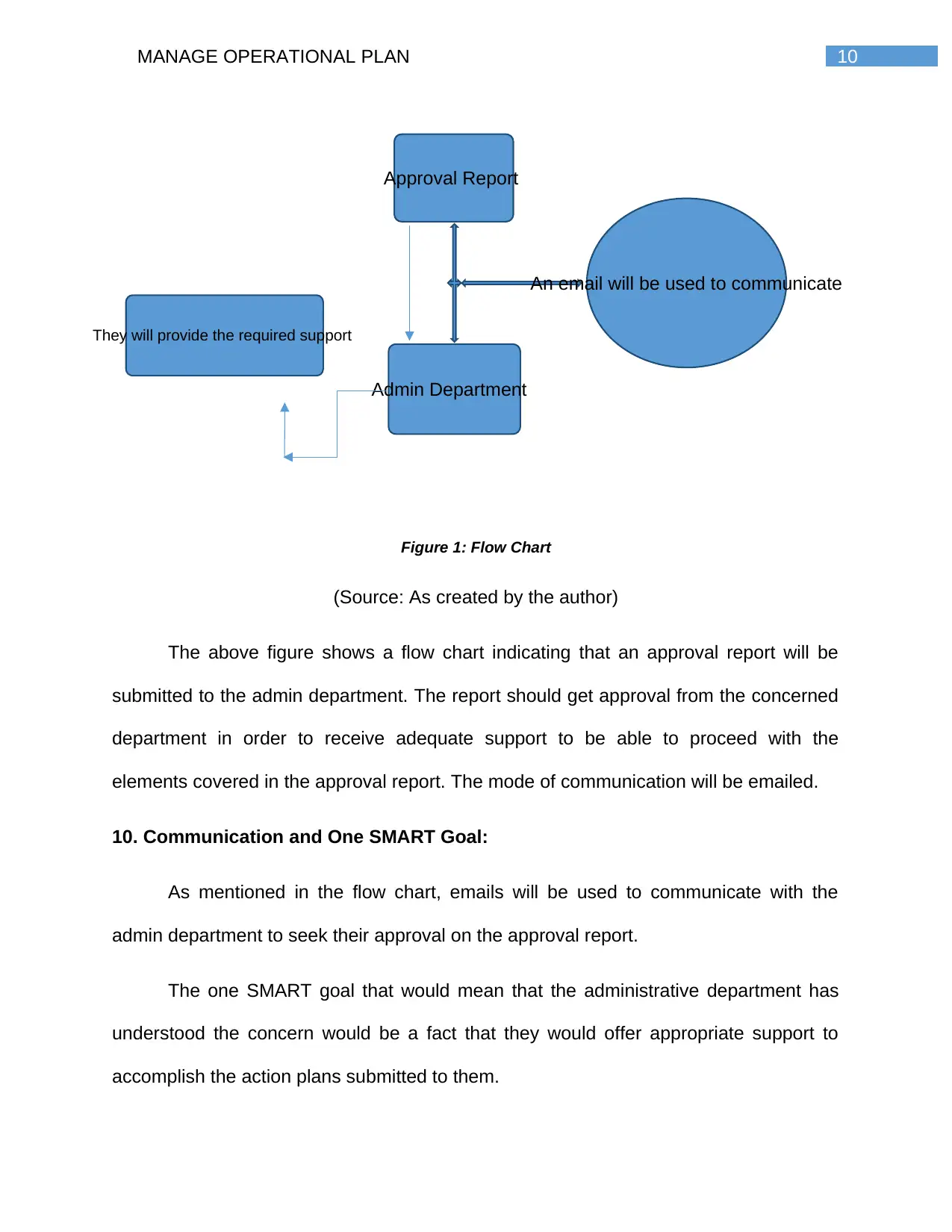
10MANAGE OPERATIONAL PLAN
Approval Report
Admin Department
An email will be used to communicate
They will provide the required support
Figure 1: Flow Chart
(Source: As created by the author)
The above figure shows a flow chart indicating that an approval report will be
submitted to the admin department. The report should get approval from the concerned
department in order to receive adequate support to be able to proceed with the
elements covered in the approval report. The mode of communication will be emailed.
10. Communication and One SMART Goal:
As mentioned in the flow chart, emails will be used to communicate with the
admin department to seek their approval on the approval report.
The one SMART goal that would mean that the administrative department has
understood the concern would be a fact that they would offer appropriate support to
accomplish the action plans submitted to them.
Approval Report
Admin Department
An email will be used to communicate
They will provide the required support
Figure 1: Flow Chart
(Source: As created by the author)
The above figure shows a flow chart indicating that an approval report will be
submitted to the admin department. The report should get approval from the concerned
department in order to receive adequate support to be able to proceed with the
elements covered in the approval report. The mode of communication will be emailed.
10. Communication and One SMART Goal:
As mentioned in the flow chart, emails will be used to communicate with the
admin department to seek their approval on the approval report.
The one SMART goal that would mean that the administrative department has
understood the concern would be a fact that they would offer appropriate support to
accomplish the action plans submitted to them.
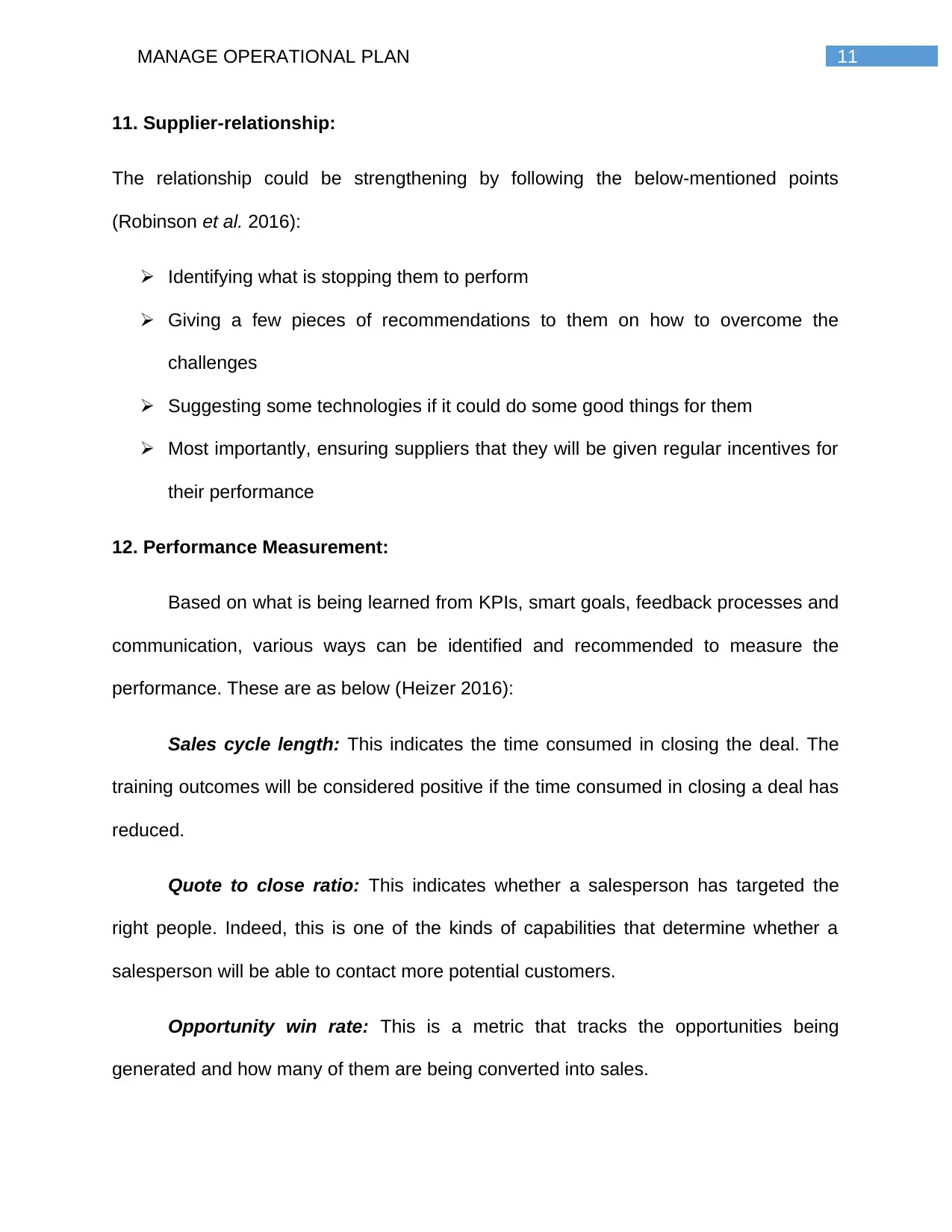
11MANAGE OPERATIONAL PLAN
11. Supplier-relationship:
The relationship could be strengthening by following the below-mentioned points
(Robinson et al. 2016):
Identifying what is stopping them to perform
Giving a few pieces of recommendations to them on how to overcome the
challenges
Suggesting some technologies if it could do some good things for them
Most importantly, ensuring suppliers that they will be given regular incentives for
their performance
12. Performance Measurement:
Based on what is being learned from KPIs, smart goals, feedback processes and
communication, various ways can be identified and recommended to measure the
performance. These are as below (Heizer 2016):
Sales cycle length: This indicates the time consumed in closing the deal. The
training outcomes will be considered positive if the time consumed in closing a deal has
reduced.
Quote to close ratio: This indicates whether a salesperson has targeted the
right people. Indeed, this is one of the kinds of capabilities that determine whether a
salesperson will be able to contact more potential customers.
Opportunity win rate: This is a metric that tracks the opportunities being
generated and how many of them are being converted into sales.
11. Supplier-relationship:
The relationship could be strengthening by following the below-mentioned points
(Robinson et al. 2016):
Identifying what is stopping them to perform
Giving a few pieces of recommendations to them on how to overcome the
challenges
Suggesting some technologies if it could do some good things for them
Most importantly, ensuring suppliers that they will be given regular incentives for
their performance
12. Performance Measurement:
Based on what is being learned from KPIs, smart goals, feedback processes and
communication, various ways can be identified and recommended to measure the
performance. These are as below (Heizer 2016):
Sales cycle length: This indicates the time consumed in closing the deal. The
training outcomes will be considered positive if the time consumed in closing a deal has
reduced.
Quote to close ratio: This indicates whether a salesperson has targeted the
right people. Indeed, this is one of the kinds of capabilities that determine whether a
salesperson will be able to contact more potential customers.
Opportunity win rate: This is a metric that tracks the opportunities being
generated and how many of them are being converted into sales.
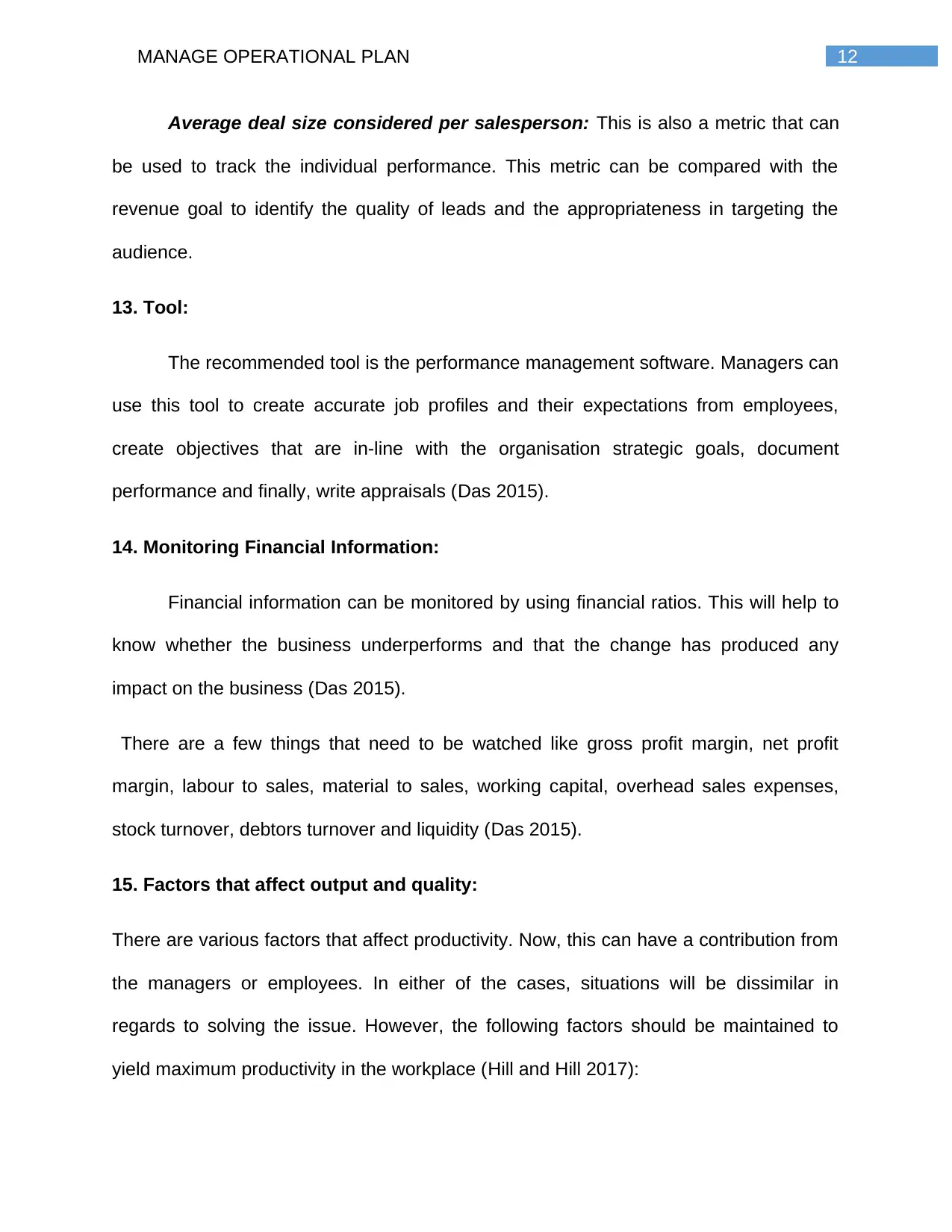
12MANAGE OPERATIONAL PLAN
Average deal size considered per salesperson: This is also a metric that can
be used to track the individual performance. This metric can be compared with the
revenue goal to identify the quality of leads and the appropriateness in targeting the
audience.
13. Tool:
The recommended tool is the performance management software. Managers can
use this tool to create accurate job profiles and their expectations from employees,
create objectives that are in-line with the organisation strategic goals, document
performance and finally, write appraisals (Das 2015).
14. Monitoring Financial Information:
Financial information can be monitored by using financial ratios. This will help to
know whether the business underperforms and that the change has produced any
impact on the business (Das 2015).
There are a few things that need to be watched like gross profit margin, net profit
margin, labour to sales, material to sales, working capital, overhead sales expenses,
stock turnover, debtors turnover and liquidity (Das 2015).
15. Factors that affect output and quality:
There are various factors that affect productivity. Now, this can have a contribution from
the managers or employees. In either of the cases, situations will be dissimilar in
regards to solving the issue. However, the following factors should be maintained to
yield maximum productivity in the workplace (Hill and Hill 2017):
Average deal size considered per salesperson: This is also a metric that can
be used to track the individual performance. This metric can be compared with the
revenue goal to identify the quality of leads and the appropriateness in targeting the
audience.
13. Tool:
The recommended tool is the performance management software. Managers can
use this tool to create accurate job profiles and their expectations from employees,
create objectives that are in-line with the organisation strategic goals, document
performance and finally, write appraisals (Das 2015).
14. Monitoring Financial Information:
Financial information can be monitored by using financial ratios. This will help to
know whether the business underperforms and that the change has produced any
impact on the business (Das 2015).
There are a few things that need to be watched like gross profit margin, net profit
margin, labour to sales, material to sales, working capital, overhead sales expenses,
stock turnover, debtors turnover and liquidity (Das 2015).
15. Factors that affect output and quality:
There are various factors that affect productivity. Now, this can have a contribution from
the managers or employees. In either of the cases, situations will be dissimilar in
regards to solving the issue. However, the following factors should be maintained to
yield maximum productivity in the workplace (Hill and Hill 2017):
Paraphrase This Document
Need a fresh take? Get an instant paraphrase of this document with our AI Paraphraser
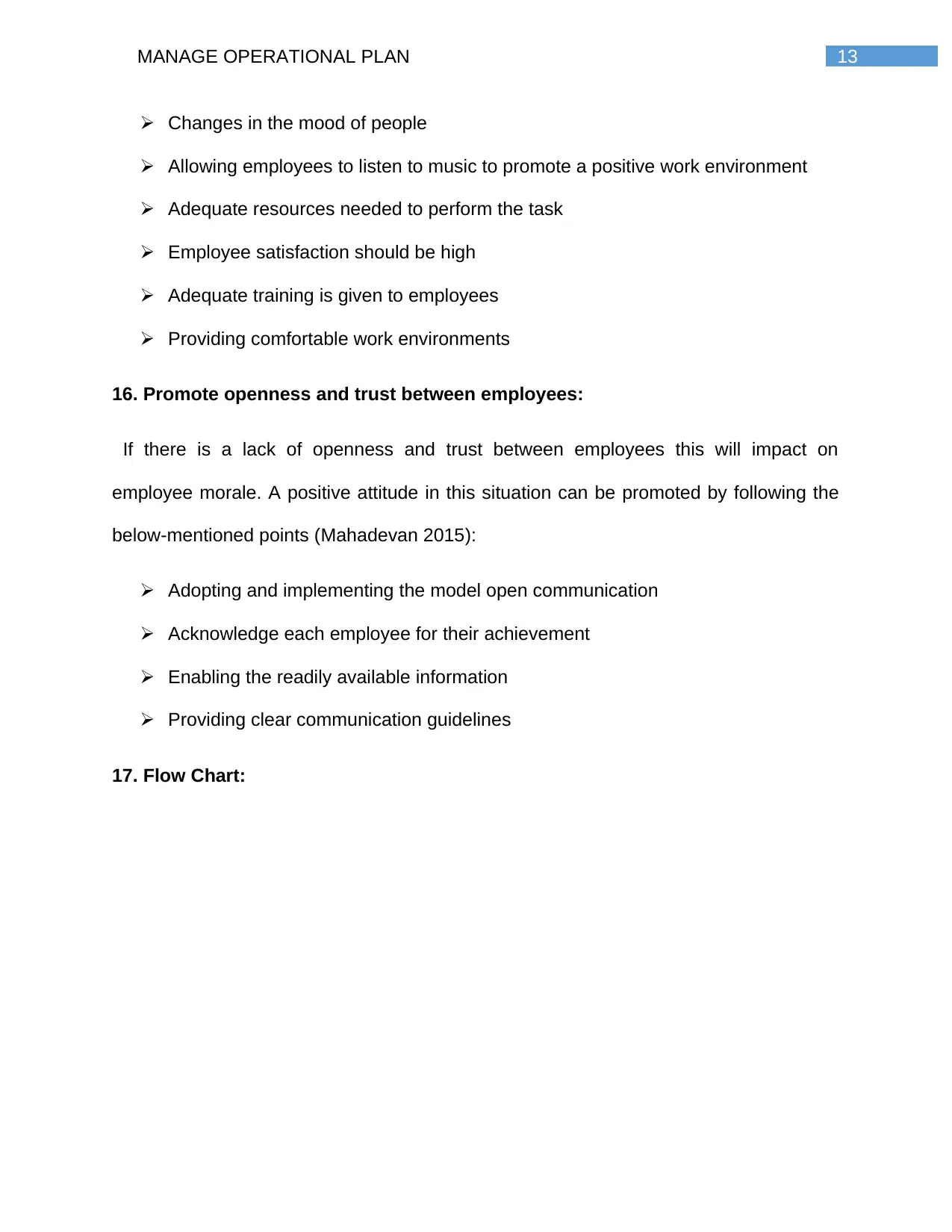
13MANAGE OPERATIONAL PLAN
Changes in the mood of people
Allowing employees to listen to music to promote a positive work environment
Adequate resources needed to perform the task
Employee satisfaction should be high
Adequate training is given to employees
Providing comfortable work environments
16. Promote openness and trust between employees:
If there is a lack of openness and trust between employees this will impact on
employee morale. A positive attitude in this situation can be promoted by following the
below-mentioned points (Mahadevan 2015):
Adopting and implementing the model open communication
Acknowledge each employee for their achievement
Enabling the readily available information
Providing clear communication guidelines
17. Flow Chart:
Changes in the mood of people
Allowing employees to listen to music to promote a positive work environment
Adequate resources needed to perform the task
Employee satisfaction should be high
Adequate training is given to employees
Providing comfortable work environments
16. Promote openness and trust between employees:
If there is a lack of openness and trust between employees this will impact on
employee morale. A positive attitude in this situation can be promoted by following the
below-mentioned points (Mahadevan 2015):
Adopting and implementing the model open communication
Acknowledge each employee for their achievement
Enabling the readily available information
Providing clear communication guidelines
17. Flow Chart:
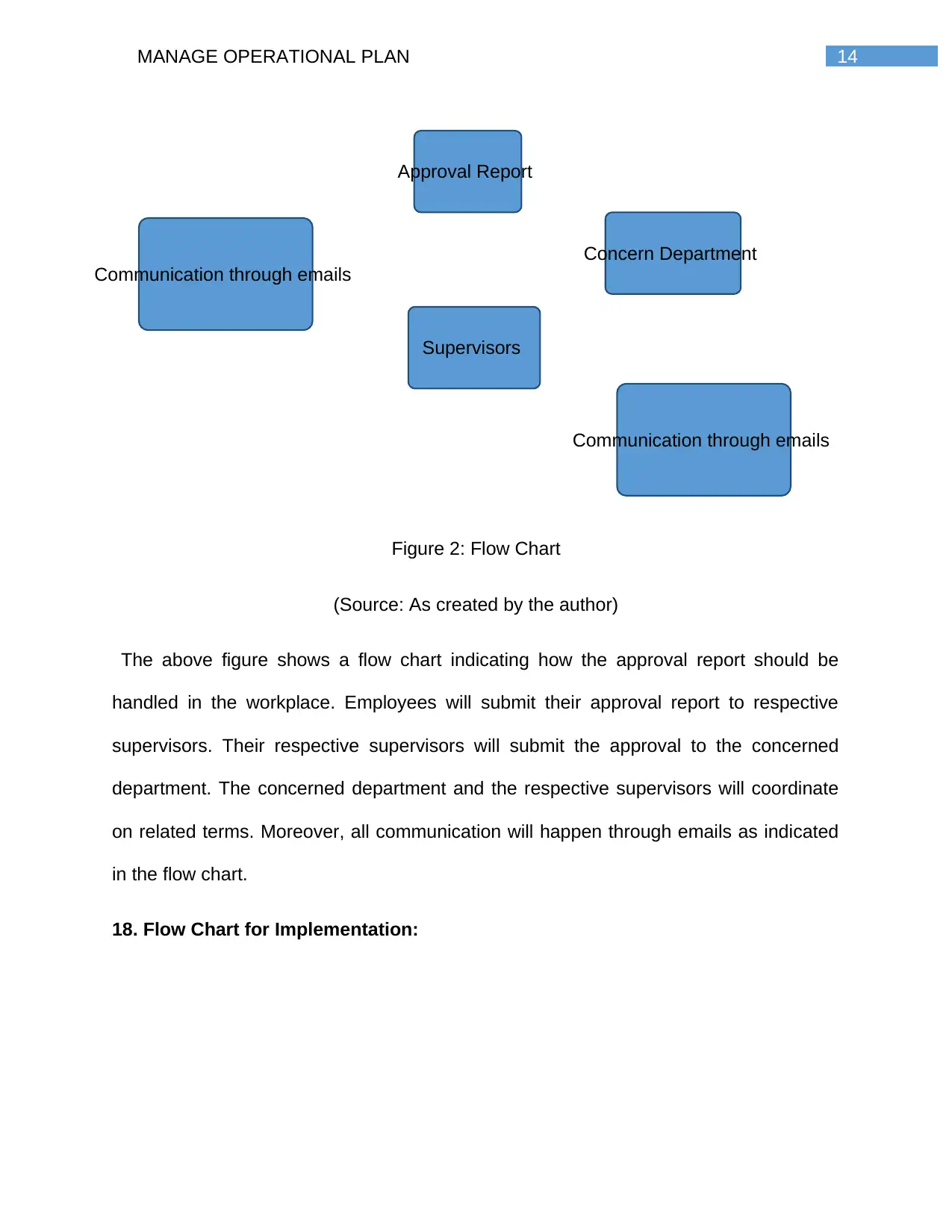
14MANAGE OPERATIONAL PLAN
Approval Report
Concern Department
Supervisors
Communication through emails
Communication through emails
Figure 2: Flow Chart
(Source: As created by the author)
The above figure shows a flow chart indicating how the approval report should be
handled in the workplace. Employees will submit their approval report to respective
supervisors. Their respective supervisors will submit the approval to the concerned
department. The concerned department and the respective supervisors will coordinate
on related terms. Moreover, all communication will happen through emails as indicated
in the flow chart.
18. Flow Chart for Implementation:
Approval Report
Concern Department
Supervisors
Communication through emails
Communication through emails
Figure 2: Flow Chart
(Source: As created by the author)
The above figure shows a flow chart indicating how the approval report should be
handled in the workplace. Employees will submit their approval report to respective
supervisors. Their respective supervisors will submit the approval to the concerned
department. The concerned department and the respective supervisors will coordinate
on related terms. Moreover, all communication will happen through emails as indicated
in the flow chart.
18. Flow Chart for Implementation:
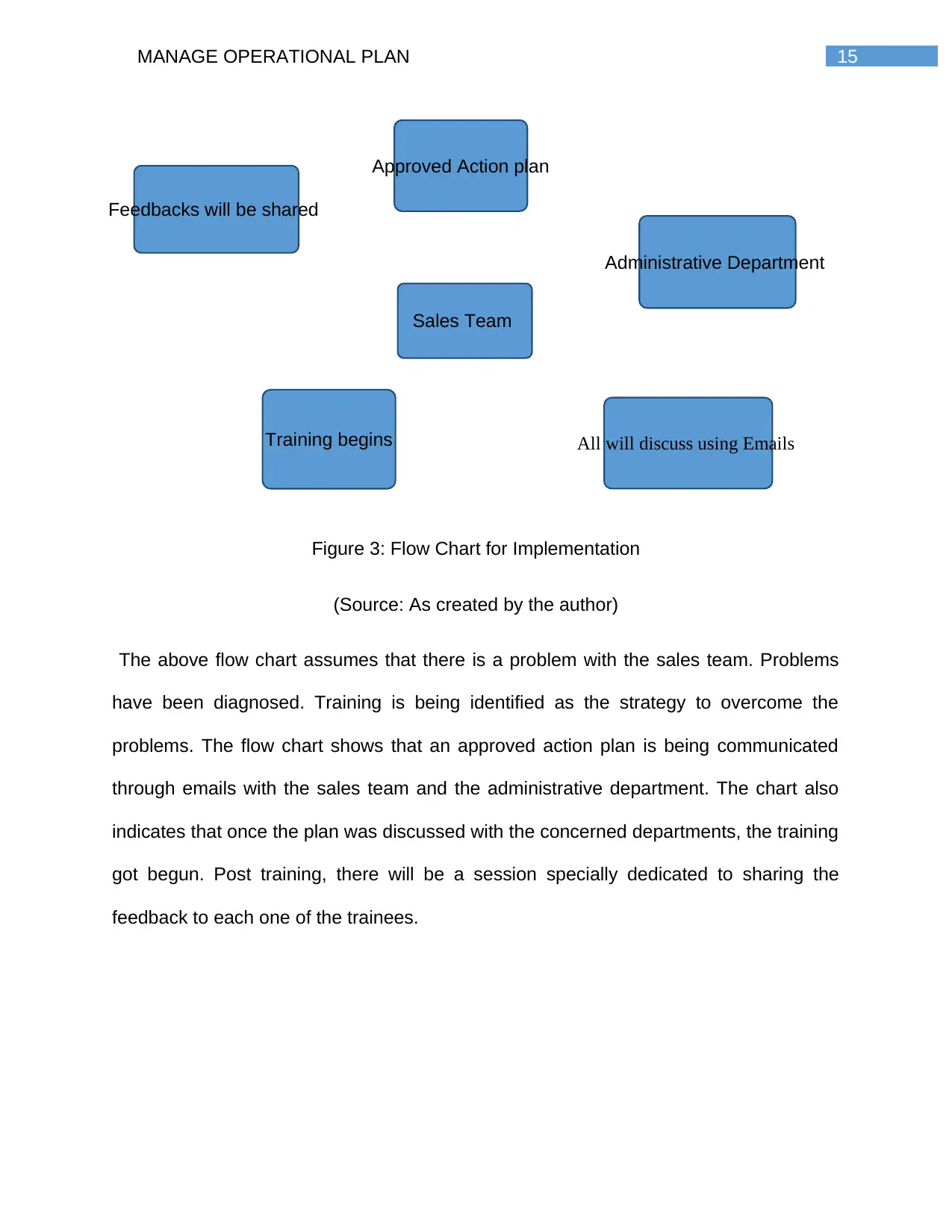
15MANAGE OPERATIONAL PLAN
Approved Action plan
Training begins
Sales Team
Administrative Department
All will discuss using Emails
Feedbacks will be shared
Figure 3: Flow Chart for Implementation
(Source: As created by the author)
The above flow chart assumes that there is a problem with the sales team. Problems
have been diagnosed. Training is being identified as the strategy to overcome the
problems. The flow chart shows that an approved action plan is being communicated
through emails with the sales team and the administrative department. The chart also
indicates that once the plan was discussed with the concerned departments, the training
got begun. Post training, there will be a session specially dedicated to sharing the
feedback to each one of the trainees.
Approved Action plan
Training begins
Sales Team
Administrative Department
All will discuss using Emails
Feedbacks will be shared
Figure 3: Flow Chart for Implementation
(Source: As created by the author)
The above flow chart assumes that there is a problem with the sales team. Problems
have been diagnosed. Training is being identified as the strategy to overcome the
problems. The flow chart shows that an approved action plan is being communicated
through emails with the sales team and the administrative department. The chart also
indicates that once the plan was discussed with the concerned departments, the training
got begun. Post training, there will be a session specially dedicated to sharing the
feedback to each one of the trainees.
Secure Best Marks with AI Grader
Need help grading? Try our AI Grader for instant feedback on your assignments.
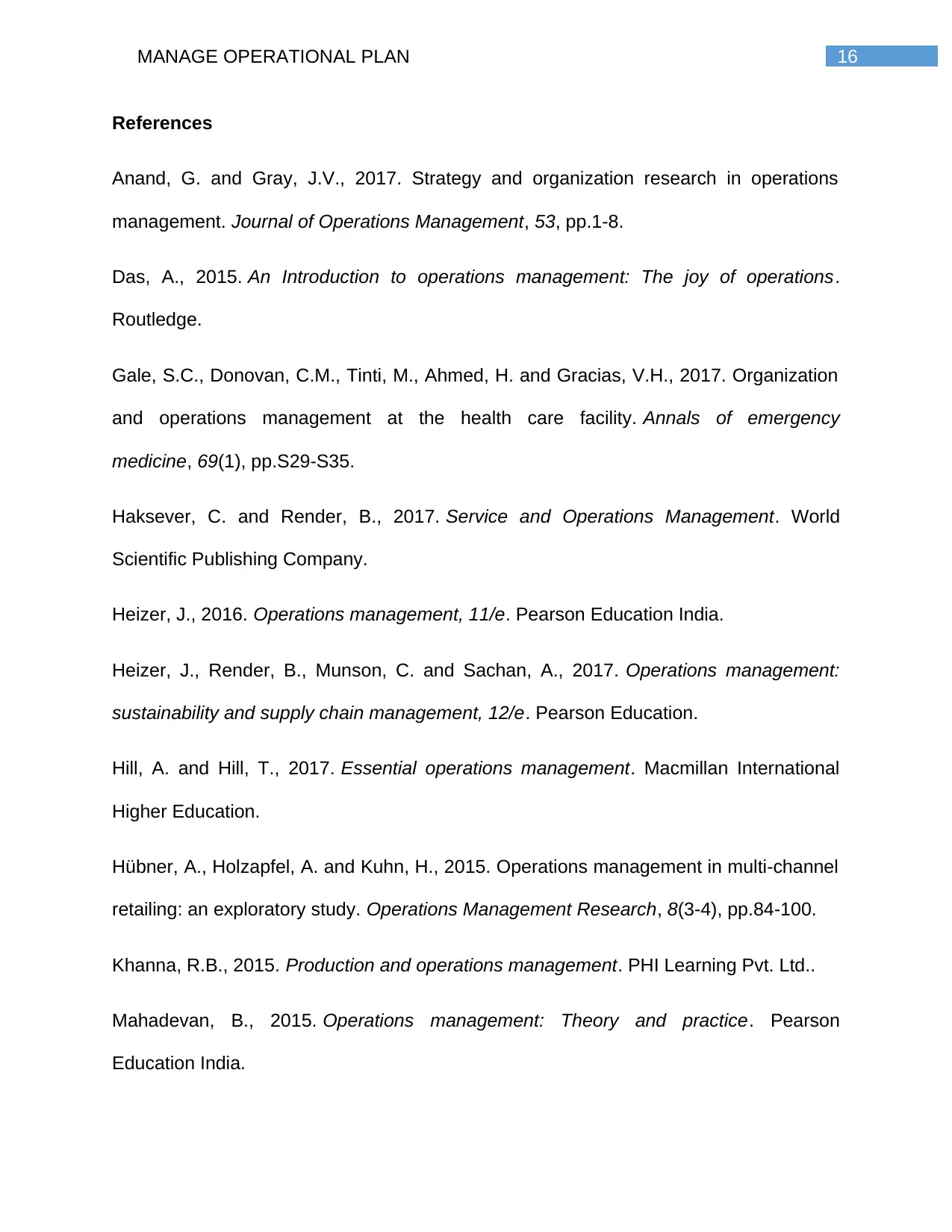
16MANAGE OPERATIONAL PLAN
References
Anand, G. and Gray, J.V., 2017. Strategy and organization research in operations
management. Journal of Operations Management, 53, pp.1-8.
Das, A., 2015. An Introduction to operations management: The joy of operations.
Routledge.
Gale, S.C., Donovan, C.M., Tinti, M., Ahmed, H. and Gracias, V.H., 2017. Organization
and operations management at the health care facility. Annals of emergency
medicine, 69(1), pp.S29-S35.
Haksever, C. and Render, B., 2017. Service and Operations Management. World
Scientific Publishing Company.
Heizer, J., 2016. Operations management, 11/e. Pearson Education India.
Heizer, J., Render, B., Munson, C. and Sachan, A., 2017. Operations management:
sustainability and supply chain management, 12/e. Pearson Education.
Hill, A. and Hill, T., 2017. Essential operations management. Macmillan International
Higher Education.
Hübner, A., Holzapfel, A. and Kuhn, H., 2015. Operations management in multi-channel
retailing: an exploratory study. Operations Management Research, 8(3-4), pp.84-100.
Khanna, R.B., 2015. Production and operations management. PHI Learning Pvt. Ltd..
Mahadevan, B., 2015. Operations management: Theory and practice. Pearson
Education India.
References
Anand, G. and Gray, J.V., 2017. Strategy and organization research in operations
management. Journal of Operations Management, 53, pp.1-8.
Das, A., 2015. An Introduction to operations management: The joy of operations.
Routledge.
Gale, S.C., Donovan, C.M., Tinti, M., Ahmed, H. and Gracias, V.H., 2017. Organization
and operations management at the health care facility. Annals of emergency
medicine, 69(1), pp.S29-S35.
Haksever, C. and Render, B., 2017. Service and Operations Management. World
Scientific Publishing Company.
Heizer, J., 2016. Operations management, 11/e. Pearson Education India.
Heizer, J., Render, B., Munson, C. and Sachan, A., 2017. Operations management:
sustainability and supply chain management, 12/e. Pearson Education.
Hill, A. and Hill, T., 2017. Essential operations management. Macmillan International
Higher Education.
Hübner, A., Holzapfel, A. and Kuhn, H., 2015. Operations management in multi-channel
retailing: an exploratory study. Operations Management Research, 8(3-4), pp.84-100.
Khanna, R.B., 2015. Production and operations management. PHI Learning Pvt. Ltd..
Mahadevan, B., 2015. Operations management: Theory and practice. Pearson
Education India.
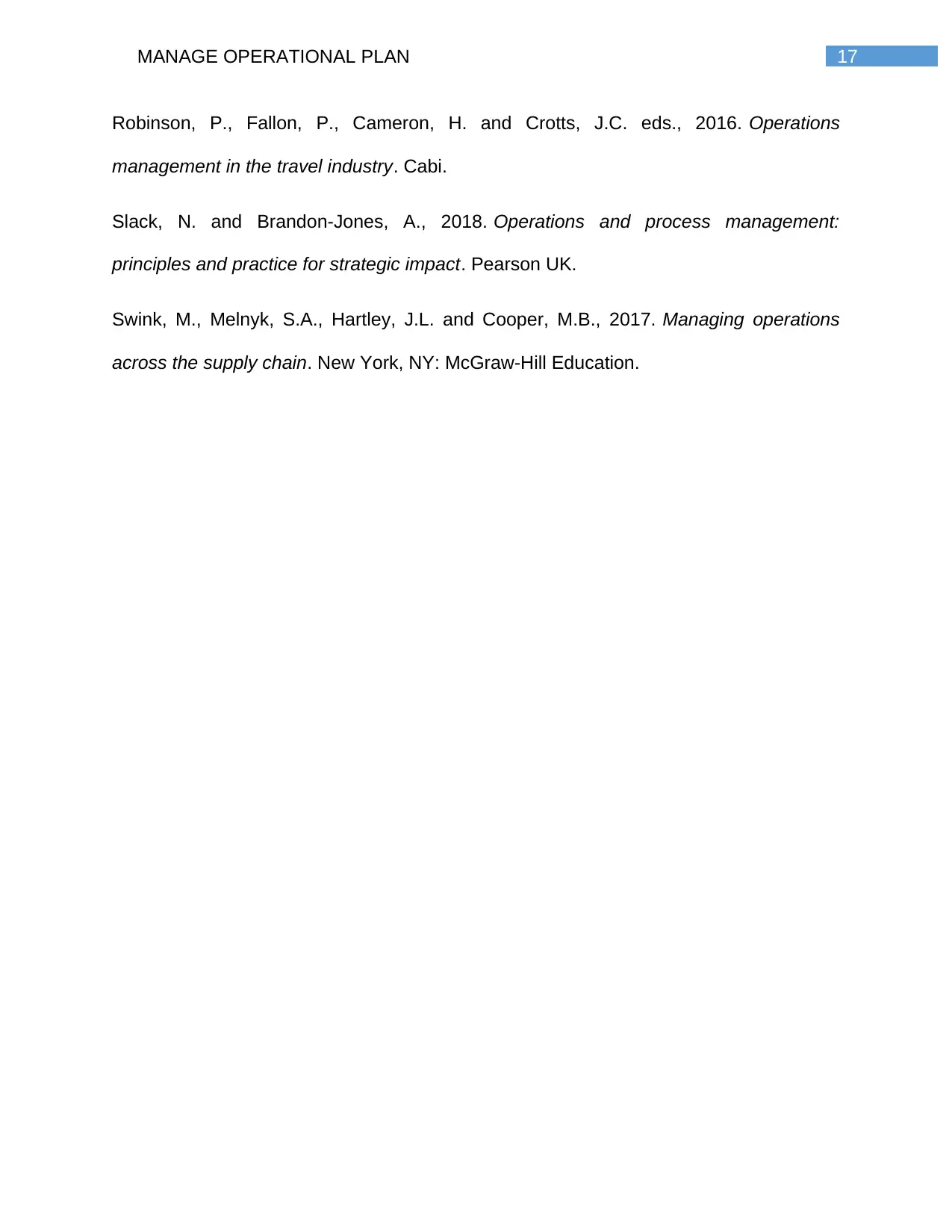
17MANAGE OPERATIONAL PLAN
Robinson, P., Fallon, P., Cameron, H. and Crotts, J.C. eds., 2016. Operations
management in the travel industry. Cabi.
Slack, N. and Brandon-Jones, A., 2018. Operations and process management:
principles and practice for strategic impact. Pearson UK.
Swink, M., Melnyk, S.A., Hartley, J.L. and Cooper, M.B., 2017. Managing operations
across the supply chain. New York, NY: McGraw-Hill Education.
Robinson, P., Fallon, P., Cameron, H. and Crotts, J.C. eds., 2016. Operations
management in the travel industry. Cabi.
Slack, N. and Brandon-Jones, A., 2018. Operations and process management:
principles and practice for strategic impact. Pearson UK.
Swink, M., Melnyk, S.A., Hartley, J.L. and Cooper, M.B., 2017. Managing operations
across the supply chain. New York, NY: McGraw-Hill Education.
1 out of 18
Related Documents
Your All-in-One AI-Powered Toolkit for Academic Success.
+13062052269
info@desklib.com
Available 24*7 on WhatsApp / Email
![[object Object]](/_next/static/media/star-bottom.7253800d.svg)
Unlock your academic potential
© 2024 | Zucol Services PVT LTD | All rights reserved.



